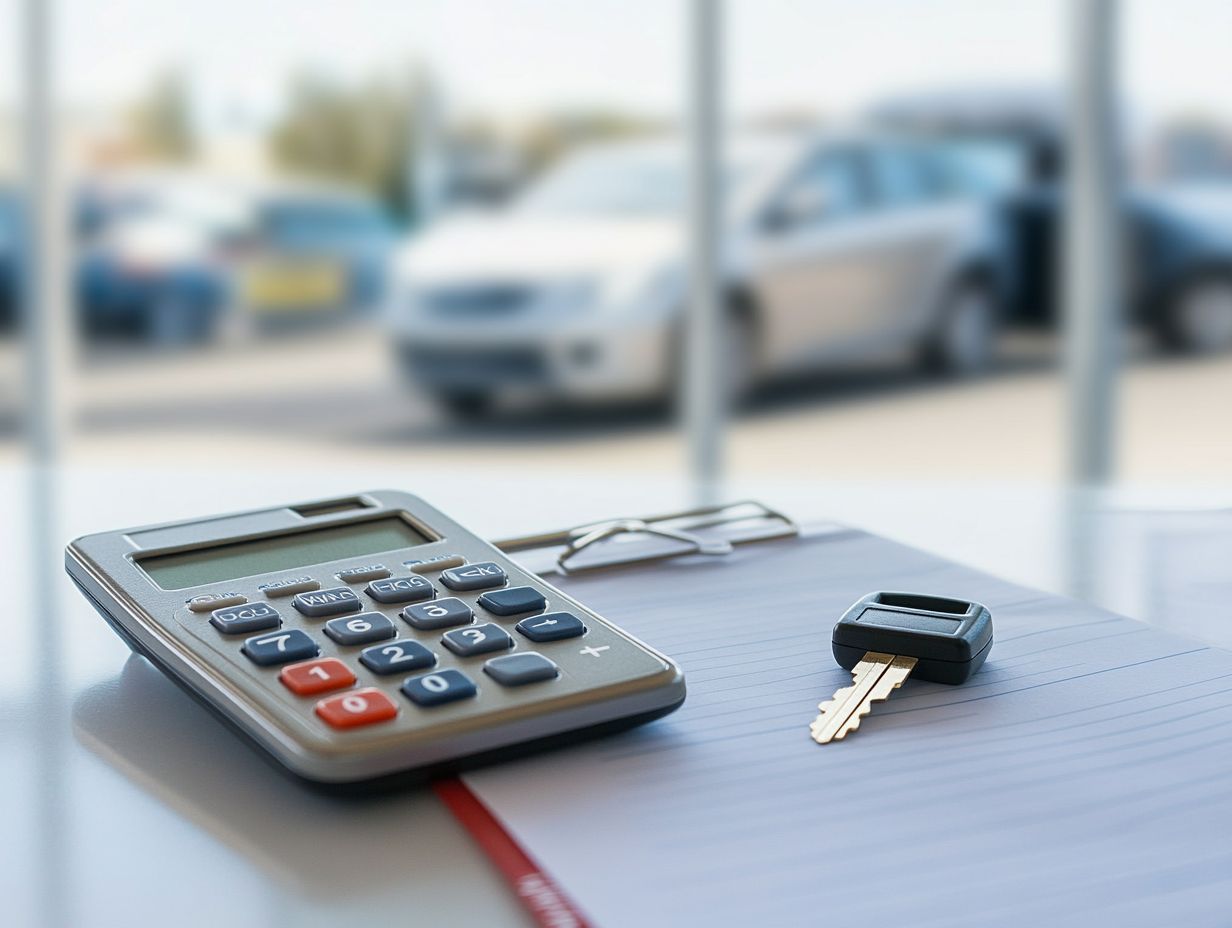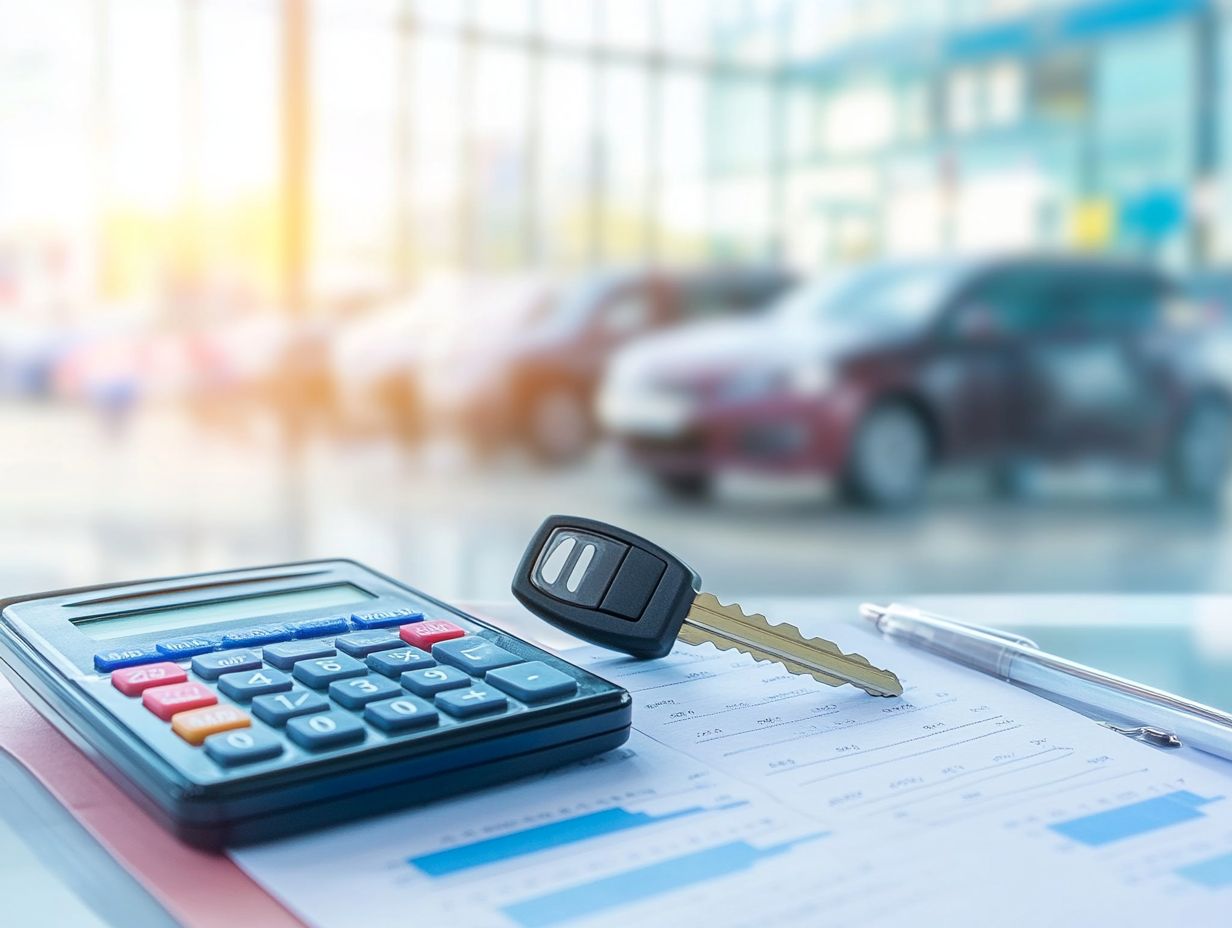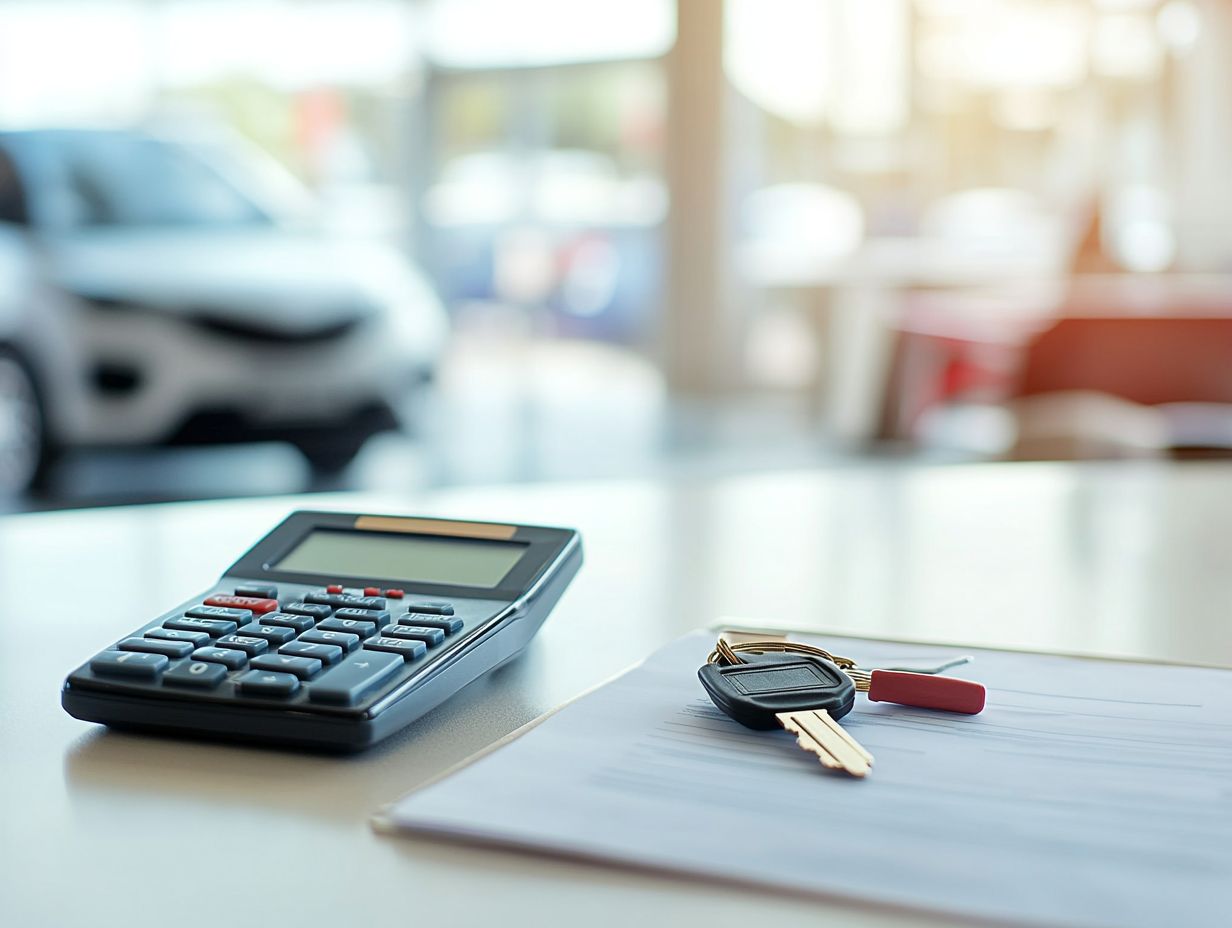5 Factors Influencing Your Car Lease Payment
Leasing a car can be an enticing choice for anyone seeking flexibility and lower monthly payments.
Several factors will significantly influence your lease payment and overall experience. Key elements include your credit score, the car’s residual value, and the lease length.
You ll also find insights into the pros and cons of leasing, tips for negotiating a better deal, and strategies to avoid unexpected fees. Whether you re new to leasing or aiming to optimize your next deal, this guide has everything you need to navigate the process with confidence!
Contents
- Key Takeaways:
- 1. Your Credit Score
- 2. The Residual Value of the Car
- 3. Length of Lease
- 4. Mileage Limit
- 5. Down Payment and Fees
- What Is a Car Lease and How Does It Work?
- Frequently Asked Questions
- What are the 5 factors that influence my car lease payment?
- How does the vehicle’s price affect my car lease payment?
- What role does the lease term play in determining my car lease payment?
- How does the interest rate affect my car lease payment?
- Why does the mileage allowance matter in my car lease payment?
- How does my credit score influence my car lease payment?
Key Takeaways:

- Your credit score greatly affects your lease payments!
- The residual value is the car’s estimated worth at the end of the lease, impacting your monthly payment.
- The duration of your lease influences your monthly payment!
1. Your Credit Score
Your credit score plays an important part in your car leasing options. It determines your eligibility for favorable lease deals and influences your monthly payments and interest rates.
Understanding how credit scores are calculated is essential. They stem from factors like payment history, credit utilization, length of credit history, types of credit, and new credit inquiries.
Financial institutions view higher scores as responsible borrowing behavior. For instance, a score above 700 can lead to lower finance charges, which may slash your monthly payments by hundreds of dollars!
Bankrate states that individuals with excellent credit can save an average of $1,100 over the lease’s life. This figure highlights the significant link between your credit health and favorable leasing terms.
2. The Residual Value of the Car
The residual value of a car is the estimated market value at the lease s end. It directly influences your lease payments and any potential lease buyout price.
Leasing companies consider factors like the make and model, historical depreciation rates, and overall market demand.
Luxury vehicles might depreciate more quickly than economy models, affecting the final figure. A higher residual value usually means lower monthly payments!
Using resources like Kelley Blue Book can help you understand a vehicle s expected depreciation. This knowledge can aid in deciding between leasing and buying.
3. Length of Lease
The length of your lease affects your overall leasing costs. It impacts everything from monthly payments to how you manage your money and potential early termination fees.
Most leases range from 24 to 60 months, each carrying unique financial implications. A shorter lease may lead to higher monthly payments, but allows for the excitement of driving a new vehicle more often.
Longer terms can lower monthly payments, but may lead to higher total leasing costs over time. Be sure to carefully consider these trade-offs!
Evaluating your needs and financial stability before committing is essential. By anticipating your future vehicle needs, you can minimize costs and enhance your overall satisfaction.
4. Mileage Limit

Mileage limits are often outlined as annual mileage in leasing contracts. They define the maximum distance you can drive your leased vehicle without incurring high mileage fees. Understand these restrictions before committing to a lease agreement.
Typically, these limits range from 10,000 to 15,000 miles per year. Some companies offer higher thresholds for an extra monthly fee. Exceeding these boundaries can accumulate penalties, costing you several cents for each extra mile.
To avoid surprises, evaluate your daily commuting habits, weekend getaways, and planned road trips when estimating your driving needs.
Stay on top of your mileage throughout the lease term. This can guide your decision on whether to request a higher limit or explore a different leasing option that better fits your driving patterns.
5. Down Payment and Fees
The down payment, or initial deposit, is an important part of car leasing. It significantly impacts your monthly payments and overall lease costs, along with other fees like security deposits and lender fees.
Allocating a larger sum for the down payment can lower your monthly payments, easing your cash flow. Understanding leasing costs is essential for planning your budget carefully. A security deposit is often required to cover potential damages and is typically refundable at lease end.
Don t overlook lender fees, which can include administrative charges that can slightly inflate your expenses. By considering these elements, you can achieve smarter budgeting and improve your financial well-being.
What Is a Car Lease and How Does It Work?
A car lease is a smart financing option that lets you drive a vehicle for a set period while making manageable monthly payments. It offers lower upfront costs and more flexible terms compared to traditional car purchases, making it appealing for many consumers.
This arrangement allows you to enjoy the benefits of a new vehicle without a long-term commitment. A leasing agreement typically outlines important details like the lease duration, mileage limits, and monthly payment amounts, which can vary based on the car s value and its estimated worth at the end of the lease.
While leasing can lower your monthly payments, watch out for potential pitfalls, such as excessive mileage fees or wear-and-tear charges. If you fall in love with the vehicle during your lease, consider the option to purchase it at the end of the term.
What Are the Pros and Cons of Leasing a Car?
Thinking about leasing a car? Here s what you need to know! Leasing a car offers a mix of advantages and drawbacks to consider. On the plus side, you enjoy benefits like lower monthly payments and maintenance coverage.
However, there are leasing traps, such as mileage restrictions and unexpected costs that can affect your finances. For many, the lure of reduced up-front costs makes leasing attractive as it allows you to drive newer models with the latest technology, all without the hefty price tag of purchasing a vehicle.
Pay attention to the fine print. Mileage fees can add up quickly if you exceed the agreed limits, leading to additional charges at the end of your lease. Additionally, early termination penalties can become an unexpected financial burden if your circumstances change.
To navigate these leasing challenges, assess your driving patterns carefully. Negotiate mileage allowances from the start and understand the lease agreement before signing. This approach ensures a smooth and enjoyable leasing experience.
Ready to take the next step? Evaluate your needs and consider consulting a leasing expert today!
How Can One Negotiate a Better Lease Deal?

Negotiating a better lease deal requires you to grasp the essential components like interest rates, monthly payments, and lease terms. This knowledge enables you to engage with the leasing company effectively and secure a more favorable agreement.
Before you step into negotiations, it s vital to conduct thorough research on the current market values for the vehicle you re eyeing. This insight gives you leverage during discussions, enabling you to compare offers and make well-informed decisions.
Understanding your credit score is also crucial, as it can significantly influence the outcome. A higher score usually translates to better terms. Also, think about the type of vehicle you lease; selecting a model in high demand can bolster your negotiating position, allowing you to confidently push for the terms you desire.
What Are the Different Types of Car Leases?
Know the different types of car leases, such as closed-end and open-end leases, to identify the leasing options that align with your needs and financial situation.
Each lease type comes with its own set of characteristics, impacting both the financial aspects and your long-term responsibilities. Closed-end leases, often dubbed ‘walk-away’ leases, offer you the convenience of returning the vehicle at the end of the lease term without the concern of its residual value (the vehicle’s estimated worth at the end of the lease term) or condition, aside from normal wear and tear.
On the other hand, open-end leases can introduce a layer of complexity; they may require you to cover the difference between the vehicle’s actual market value and the agreed-upon buyout price, placing greater emphasis on the vehicle’s residual value. This distinction is vital for budget-conscious individuals who wish to sidestep unexpected costs, as well as for those comfortable with potentially assuming a buyout obligation depending on market conditions.
What Happens at the End of a Car Lease?
At the conclusion of your car lease, you have several options. You can return the vehicle, negotiate a lease buyout at the residual value, or trade it in for a new lease. Each choice comes with its own set of procedures, including a vehicle inspection.
Grasping these processes is essential for making informed choices. Vehicle inspections evaluate the car’s condition and often reveal any extra fees for wear and tear or necessary repairs, which can affect your overall expenses.
Understanding the trade-in value gives you valuable insight into what you might gain from trading in the vehicle versus opting for a lease buyout. This knowledge enables you to make better comparisons and thoroughly assess the financial advantages of each option available at the end of the lease. By being well-prepared, you can maximize your investment and navigate this transition with confidence.
How to Avoid Extra Fees and Charges When Leasing a Car?
Avoiding extra fees and charges while leasing a car is all about staying informed. You need to familiarize yourself with common leasing pitfalls, adhere to lease conditions, and understand your leasing rights to safeguard your finances throughout the leasing term.
Regular vehicle maintenance is your best friend here. By keeping your vehicle in excellent condition, you can prevent penalties related to excessive wear and tear. It s also crucial to be mindful of mileage limits; exceeding these can lead to hefty charges that nobody wants to deal with. Negotiating the lease terms upfront allows you to clarify stipulations and tailor the agreement to fit your driving habits and financial situation perfectly.
Being aware of your rights enables you to challenge any unexpected fees that may pop up during the leasing period, giving you an extra layer of security and confidence in your leasing experience.
Frequently Asked Questions

What are the 5 factors that influence my car lease payment?
The 5 factors that influence your car lease payment are the vehicle’s price, lease term, interest rate, mileage allowance, and your credit score, which are crucial elements to consider when leasing a car.
How does the vehicle’s price affect my car lease payment?
The vehicle’s price directly influences your car lease payment, serving as the basis for calculating the monthly payment. For those looking for better options, consider these 5 tips for finding the best lease deals.
What role does the lease term play in determining my car lease payment?
The lease term is the length of the lease agreement. A longer lease term means lower monthly payments.
However, a shorter lease term can save you money in the long run by reducing interest costs.
How does the interest rate affect my car lease payment?
The interest rate on your car lease is often called the money factor, which refers to the interest you pay on your lease. A higher interest rate results in a higher monthly payment.
Conversely, a lower rate can significantly reduce your payment.
Why does the mileage allowance matter in my car lease payment?
The mileage allowance refers to the number of miles permitted each year in your lease. Exceeding this limit incurs additional fees.
Choosing the right mileage allowance is crucial to keep your costs down!
How does my credit score influence my car lease payment?
Your credit score heavily influences your car lease payment. For instance, understanding the key factors in car ownership costs can help you secure a higher score, which can lead to lower interest rates and better lease terms.
On the other hand, a lower score may result in higher payments or disqualification from leasing.






